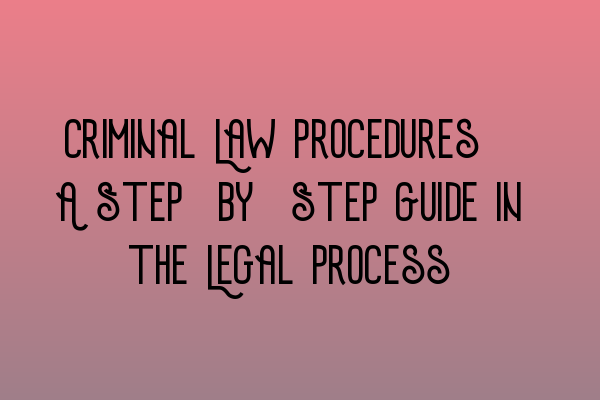Criminal Law Procedures: A Step-by-Step Guide in the Legal Process
Introduction
Criminal law procedures play a crucial role in maintaining justice and ensuring fair legal proceedings. Whether you are a law student preparing for the SQE exams or an individual interested in understanding the criminal justice system, this comprehensive guide will provide you with a step-by-step overview of the legal process. Let’s dive in!
1. Investigation
The first step in criminal law procedures is the investigation. This involves gathering evidence, conducting interviews, and collecting any relevant information related to the alleged crime. Investigators meticulously piece together the puzzle, aiming to uncover the truth.
To learn more about the investigation process, check out our SQE 1 Practice Exam Questions article.
2. Arrest
Once the investigation is complete and there is sufficient evidence, the authorities may proceed with an arrest. The arrested individual is then taken into custody to ensure their presence throughout the legal process.
If you’re curious about the arrest procedure, our article on SQE 1 Practice Mocks FLK1 FLK2 will provide you with further insights.
3. Charging
After the arrest, the prosecution will determine if there is enough evidence to formally charge the accused. This is a critical step in the criminal law procedures as it establishes the basis for the legal case against the defendant.
If you’re interested in learning more about charging, check out our comprehensive guide on SQE 2 Preparation Courses.
4. Bail or Detention
Once charged, the accused individual may have the option of seeking bail or may be held in detention. The decision depends on various factors, including the severity of the alleged crime and the risk of the individual fleeing.
To delve deeper into the concept of bail and detention, our SQE 1 Preparation Courses article provides an in-depth analysis.
5. Pre-Trial Procedures
Prior to the trial, several pre-trial procedures take place. This includes the exchange of evidence between the prosecution and defense, motions, hearings, and negotiations. These procedures help set the stage for the trial itself.
To have a better understanding of the pre-trial procedures, check out our article on SRA SQE Exam Dates.
6. Trial
The trial is where the prosecution presents their case against the defendant, and the defense has the opportunity to provide counterarguments. Both sides present evidence, call witnesses, and make legal arguments to persuade the judge or jury of their position.
For more information about the trial process, our comprehensive guide on SQE 1 Practice Exam Questions will be of great help.
7. Verdict and Sentencing
After carefully considering the evidence and arguments, the judge or jury delivers a verdict. If the defendant is found guilty, the sentencing phase begins, where the appropriate punishment is determined based on the severity of the crime and any relevant mitigating or aggravating factors.
If you want to explore the concept of verdict and sentencing in more detail, our guide on SQE 2 Preparation Courses is a valuable resource.
8. Appeals
In some cases, the convicted individual or the prosecution may choose to appeal the verdict or the sentence. The appeals process allows for further review of the trial to ensure that legal errors were not made and that justice is served.
To gain a deeper understanding of the appeals process, we recommend reading our article on SRA SQE Exam Dates.
Conclusion
The criminal law procedures guide presented here provides a comprehensive overview of the legal process, from investigation to appeals. Understanding these steps is essential for anyone interested in criminal law or preparing for the SQE exams.
If you have any further questions or want to explore specific topics in more detail, feel free to reach out to us at SQE Criminal Law & Practice Law UK.
